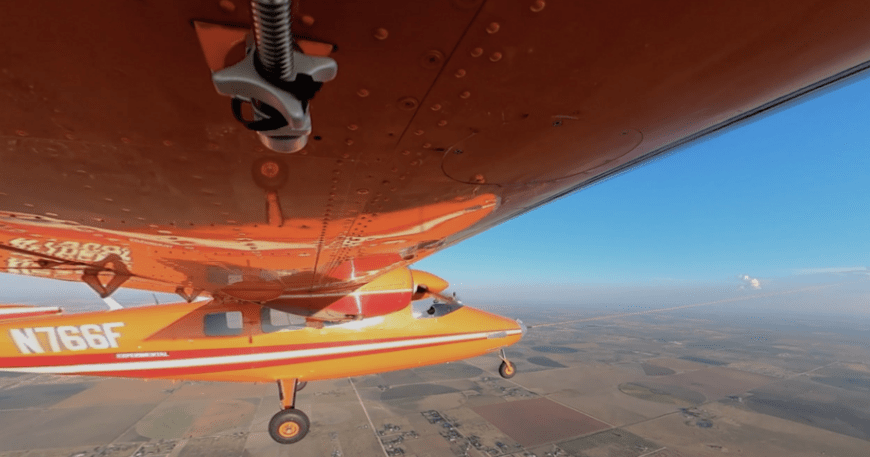A Texas start-up, Aerolane, is putting the spotlight on an innovative approach to air cargo. Inspired by how geese fly in a V-formation, Aerolane is developing cargo gliders known as the “flying piano,” aimed at revolutionising air freight. This unique method relies on one plane towing another to surf the air currents created by the aircraft ahead.
This fresh take on air cargo aims to reduce fuel consumption significantly. Aerolane’s gliders are designed to glide long distances with minimal fuel, potentially changing how goods are transported through the skies. By leveraging air currents, these gliders could lessen the environmental impact of air freight, presenting a promising future for the industry.
The Concept of Airborne Surfing
A Texas start-up named Aerolane is developing cargo gliders, dubbed the “flying piano”, inspired by the way geese fly in a V-formation. This method allows geese to surf on the air currents created by the birds in front of them. Aerolane aims to use this concept to revolutionise air cargo by using modified planes towed into the air by another aircraft.
Testing and Data Collection
At an airfield in Texas, experiments have involved releasing smoke from the leading plane to capture air vortices that the glider can exploit to stay in flight. One of the test aircraft, known as the “flying piano” due to its poor gliding characteristics, uses its twin engines for electrical power while gliding. Tension in the towing line is also measured to determine when the glider is effectively surfing on the lead aircraft’s air currents.
Practical Applications
Aerolane plans to utilise collected data to guide unmanned cargo planes through wakes and turbulence, enabling them to glide long distances with minimal fuel consumption. The theory is akin to a truck pulling a trailer, with air currents doing much of the heavy lifting. A jet carrying cargo could tow one or more of these gliders to their destination, where they would land autonomously.
Comparison to Airbus’ Experiment
Airbus tested a similar concept in 2021 with two A350 airliners flying 3km apart across the Atlantic. Although not connected by a tow line, the trailing aircraft benefited from the lead aircraft’s wake, reducing CO2 emissions and fuel consumption. Similarly, Aerolane’s concept seeks to minimise fuel use by leveraging air currents, but with towed gliders for cargo.
Safety Measures
Flying large gliders in commercial airspace requires compliance with strict safety regulations. The towing aircraft must be able to release the tow line at any time, ensuring the glider can safely land. Aerolane’s cargo gliders are equipped with a small electric motor as a safety net, allowing them to divert if necessary. These measures aim to address concerns regarding public acceptance of unpowered cargo flights over populated areas.
Expert Opinions
Freight businesses are interested in any innovation that lowers delivery costs. Alongside fuel savings, air freight firms consider engine emissions and pilot shortages. James Earl, an aviation consultant, believes gains can be made by combining efforts in the sky. However, public acceptance of cargo gliders remains a challenge. Mr Earl emphasises the importance of effective communication regarding safety measures.
FAA Compliance
Regulators, particularly the US Federal Aviation Administration (FAA), remain cautious. Todd Graetz, a co-founder of Aerolane, states that the company complies with all FAA requirements. Fred Lopez, with 36 years in aviation operations, was initially sceptical but was convinced by the potential fuel savings. Lopez now serves on Aerolane’s advisory board, supporting the project’s adherence to safety and regulatory standards.
Future Goals
Aerolane’s ultimate aim is to achieve autonomous operation using AI. The initial design incorporates a human safety pilot alongside autopilot systems to ease FAA certification. Lopez highlights that Aerolane is making gradual changes, not attempting to overhaul everything at once. The vision is to eventually eliminate the need for pilots altogether using advanced AI technologies.
Economic Implications
Cutting fuel costs is a major focus in civil aviation. The introduction of upturned wingtips reduced fuel costs by about 5%. Similarly, Aerolane’s gliders aim to drastically cut fuel consumption. A jet towing two gliders could significantly reduce fuel usage for large shipments, presenting a cost-effective and environmentally friendly alternative to traditional air cargo methods.
Public Perception and Challenges
Despite the promising technology, public acceptance is a significant hurdle. Concerns about the safety and reliability of unpowered cargo flights over urban areas must be addressed. Effective communication about safety measures and benefits is crucial. Aerolane continues to engage with regulatory bodies and the public to build trust and demonstrate the viability of their innovative approach to air cargo transportation.
In conclusion, Aerolane’s innovative approach to air cargo through the use of “flying pianos” presents a promising future for the industry. This technology aims to drastically reduce fuel consumption, offering a cost-effective and environmentally friendly alternative to traditional air freight methods.
However, significant challenges remain, particularly in gaining public acceptance and regulatory approval. Communicating the safety measures and benefits to the public is crucial. If successful, Aerolane’s technology could revolutionise how goods are transported through the skies.

